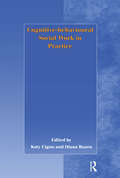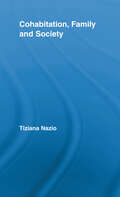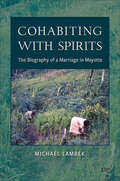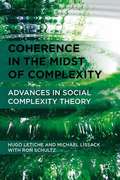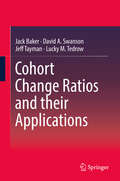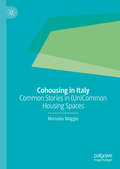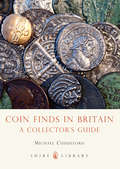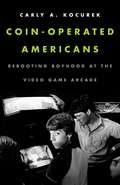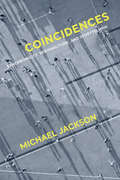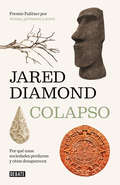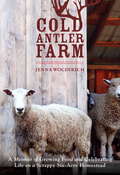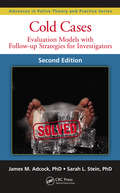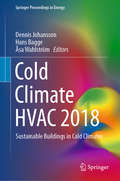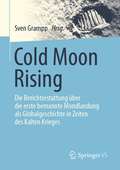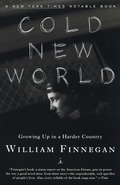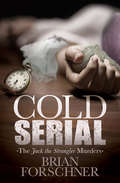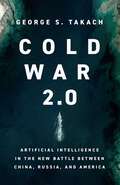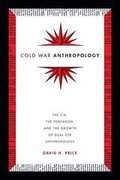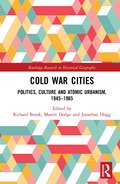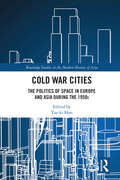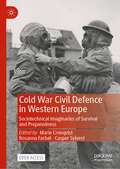- Table View
- List View
Cognitive-behavioural Social Work in Practice
by Katy Cigno Diana BournCognitive-Behavioural Social Work in Practice appears at an interesting time for social work and social services. More than ever, practitioners are required to provide evidence for the effectiveness of what they do, while the rights of service users to ethically competent practice in which they are partners is high on the agenda. Drawing on a wide area of research, as well as the practice experience of its 18 contributors, it covers a broad range of cognitive-behavioural intervention with different client groups in a variety of settings, including child care, family work, probation and offending behaviour, mental health, disability and issues concerning older people. The first chapter sets out lucidly the theoretical and research basis for cognitive-behavioural practice and is rich in case examples. Each subsequent chapter adopts a case study approach to its subject, either by providing a single case study or by the detailed exploration of an area of practice combined with case examples. The volume is unique in not only bringing together practitioners and academics but in presenting the work of the 'academic, reflective practitioner'. It is thus an accessible, informative guide for professionals, students and educators who, with all their working pressures and constraints, strive to provide help based on best evidence.
Cohabitation, Family & Society (Routledge Advances in Sociology #Vol. 36)
by Tiziana NazioThis book deals with the process of the diffusion of cohabitation in Europe and discusses its impact upon fundamental changes in family formation. It makes use of highly dynamic statistical modelling that takes into account both changes occurring along the life course (individuals’ biographies) and across birth cohorts of individuals (generational change) in a comparative perspective. It is thus innovative methodologically, but is written in such a way as to be easily readable by those with little knowledge of quantitative methods. The approach proposed is empirically tested on a selection of European countries: the social democratic Sweden, the conservative-corporatist France and West Germany, the former socialist East Germany, and the familistic Italy and Spain. The theory and its application are described in a clear and simple manner, making the arguments and their illustrations accessible to those from a variety of disciplines. The study shows evidence of the ‘contagiousness’ of cohabitation, providing new insights on a process relevant to many social science debates. It is thus directed to those interested in the mechanisms driving social and cultural change, the nature of demographic changes, as well as diffusion processes.
Cohabiting with Spirits: The Biography of a Marriage in Mayotte (Anthropological Horizons)
by Michael LambekPossession aptly describes the explicit manifestations of spirits when they temporarily displace individuals by assuming control of their bodies and minds, but the word does not account for what it means to cohabit with them. Cohabiting with Spirits offers an intimate portrait of the intertwined lives of a married couple together with the various spirits who came to possess each of them. Set against the backdrop of the island of Mayotte during the twentieth century, the book paints a vivid picture of the couple’s lives, navigating the demands of their respective spirits while practising an art of cohabitation, both with the spirits and with each other. While studies of spirit possession often focus on ceremonial practices and dramatic performances of spirit mediums in trance, Michael Lambek shifts the focus to explore what it can be like to cohabit with spirits. The book examines the ways in which various spirits entered the lives of this married couple and how their presence shaped the hosts’ careers as healers, leaving lasting impacts on their domestic and personal lives. Based on rich ethnographic research conducted over the course of several decades, Cohabiting with Spirits presents a rare biography of “ordinary” Africans in the twentieth century and celebrates the resilience of a strong marriage.
Coherence in the Midst of Complexity
by Ron Schultz Hugo Letiche Michael LissackAdiscussion onthe social complexity approach, where dialogue and stories allow for the degrees of freedom needed for the opportunities of emergence to take root. The authors focus on the experience of coherence and how such experiential lessons differ from the establishment and maintenance of categories and labels. "
Cohort Change Ratios and their Applications
by Jack Baker David A. Swanson Jeff Tayman Lucky M. TedrowThis textbook focuses on the cohort change ratio (CCR) method. It presents powerful, yet relatively simple ways to generate accurate demographic estimates and forecasts that are cost efficient and require fewer resources than other techniques. The concepts, analytical frameworks, and methodological tools presented do not require extensive knowledge of demographics, mathematics, or statistics. The demographic focus is on the characteristics of populations, especially age and sex composition, but these methods are applicable estimating and forecasting other characteristics and total population. The book contains more traditional applications such as the Hamilton-Perry method, but also includes new applications of the CCR method such as stable population theory. Real world empirical examples are provided for every application; along with excel files containing data and program code, which are accessible online. Topics covered include basic demographic measures, sources of demographic information, forecasting and estimating (both current and historical) populations, modifications to current methods, forecasting school enrollment and other characteristics, estimating life expectancy, stable population theory, decomposition of the CCR into its migration and mortality components, and the utility of the CCR. This textbook is designed to provide material for an advanced undergraduate or graduate course on demographic methods. It can also be used as a supplement for other courses including applied demography, business and economic forecasting and market research.
Cohousing in Italy: Common Stories in (Un)Common Housing Spaces
by Manuela MaggioThis book investigates cohousing in Italy, a housing model that is both underused and often overlooked. By engaging cohousers’ stories and applying a sociological lens, it brings to light their lived experiences while tracing the history and evolution of this alternative housing model in Italy. The book is structured in three parts. It begins by taking readers through the evolving landscape of housing in Italy and explores the unique features of the local housing context, tracing the historical shifts in how public and social housing have been understood and implemented. Moving into the realm of collaborative living, the second part delves into the state of cohousing in Italy—its roots, current practices, and defining characteristics. The third part turns to the public cohousing model, offering actionable insights and practical recommendations for researchers, professionals, and advocates working to reimagine housing as a space for connection and community.
Coin Finds in Britain
by Michael CuddefordThe purpose of this book is to provide the reader with an overview of the types of coins commonly found in the soil of Britain. Coin finds occur with surprising regularity and are commonly uncovered by gardeners and building workers, but more often by archaeologists and metal detector users. Although there are numerous catalogues available for reference, these tend to be quite expensive and also very detailed, listing numerous coins that, while familiar to collectors, rarely if ever find their way into the ground as casual losses. The aim of this book is to provide a 'one-stop shop' for the entire range of coins, tokens and counters most commonly found in Britain and to serve as a point of first reference for academics, collectors, metal detector users and history students alike. TOC: Britain's Buried Coinage / Iron Age Coins / Roman Coins / Medieval Coins / Early Post-medieval Coins / Later Coins / Recording Coin Finds / Further Reading / Index
Coin-Operated Americans: Rebooting Boyhood at the Video Game Arcade
by Carly A. KocurekVideo gaming: it&’s a boy&’s world, right? That&’s what the industry wants us to think. Why and how we came to comply are what Carly A. Kocurek investigates in this provocative consideration of how an industry&’s craving for respectability hooked up with cultural narratives about technology, masculinity, and youth at the video arcade.From the dawn of the golden age of video games with the launch of Atari&’s Pong in 1972, through the industry-wide crash of 1983, to the recent nostalgia-bathed revival of the arcade, Coin-Operated Americans explores the development and implications of the &“video gamer&” as a cultural identity. This cultural-historical journey takes us to the Twin Galaxies arcade in Ottumwa, Iowa, for a close look at the origins of competitive gaming. It immerses us in video gaming&’s first moral panic, generated by Exidy&’s Death Race (1976), an unlicensed adaptation of the film Death Race 2000. And it ventures into the realm of video game films such as Tron and WarGames, in which gamers become brilliant, boyish heroes.Whether conducting a phenomenological tour of a classic arcade or evaluating attempts, then and now, to regulate or eradicate arcades and coin-op video games, Kocurek does more than document the rise and fall of a now-booming industry. Drawing on newspapers, interviews, oral history, films, and television, she examines the factors and incidents that contributed to the widespread view of video gaming as an enclave for young men and boys.A case study of this once emergent and now revived medium became the presumed enclave of boys and young men, Coin-Operated Americans is history that holds valuable lessons for contemporary culture as we struggle to address pervasive sexism in the domain of video games—and in the digital working world beyond.
Coincidences: Synchronicity, Verisimilitude, and Storytelling
by Michael JacksonMost people have a story to tell about a remarkable coincidence that in some instances changed the course of their lives. These uncanny occurrences have been variously interpreted as evidence of divine influence, fate, or the collective unconscious. Less common are explanations that explore the social situations and personal preoccupations of the individuals who place the most weight on coincidences. Drawing on a variety of coincidence stories, renowned anthropologist Michael Jackson builds a case for seeing them as allegories of separation and loss—revealing the hope of repairing sundered lives, reconnecting estranged friends, reuniting distant kin, closing the gap between people and their gods, and achieving a sense of emotional and social connectedness with others in a fragmented world.
Colapso México: Los culpables y las víctimas de nuestra crisis climática
by Mael VallejoYA ESTAMOS VIVIENDO UNA CRISIS PEOR QUE LA PANDEMIA. La crisis ambiental se cobrará más vidas y golpeará más duraderamente a México que el Covid-19, simplemente no hemos querido verlo. Los reportajes de este libro retratan las caras que ya presenta este fenómeno en el país: el horror de los huracanes en Centroamérica y la inundación migratoria que desatan, la confluencia de los vientos del Polo Norte con la minería más salvaje, el vínculo entre la llegada de un tren y la agonía del jaguar, la sangre que derrama la tala clandestina, el agua como vida y muerte de personas y poblados, y la relación entre el silencio y las piedras en los pulmones, entre otros. En Colapso México, algunos de los periodistas más importantes de la región documentan que, más allá de la amenaza real del calentamiento global, es necesario actuar ya ante la avaricia desbocada de los empresarios y la falta de regulación y entendimiento del problema de las autoridades. Afortunadamente, en este diagnóstico viene también el germen de la solución...
Colapso: Por qué unas sociedades perduran y otras desaparecen
by Jared DiamondJared Diamond se pregunta cómo unas sociedades que han desaparecido sin apenas dejar huella de su evolución han alcanzado una próspera civilización material y cultural. A través de sus amplios conocimientos en sociología, economía, lingüística, biología o antropología, Diamond trata de explicar la desaparición de sociedades del pasado y se pregunta si podemos aprender la lección y evitar desastres parecidos en el futuro. El punto de partida es una rigurosa investigación de los casos de culturas que no han perdurado: historias trágicas como la de los mayas, la de la Isla de Pascua o la de los indios anasazi en Norteamérica; historias menos terribles como la de Islandia o de Japón, culturas que han sabido reaccionar con éxito a desafíos ambientales; historias también de vencedores y vencidos, como el caso de la República Dominicana y de Haití, dos pueblos que a pesar de compartir el mismo medio ambiente han evolucionado de modos muy distintos, y finalmente historias aún abiertas como las de China o Australia, que están buscando soluciones innovadoras a sus desafíos ecológicos y sociales. ¿Qué lección podemos aprender del pasado? ¿Está nuestro futuro en peligro? Las respuestas que ofrece este libro no son catastróficas, pero al mismo tiempo nos advierten de la urgencia de tomar decisiones cuanto antes si queremos seguir admirando las ruinas de otros pueblos que nos han precedido. Reseñas:«Uno de los proyectos intelectuales más significativos de nuestra generación.»The New York Times «En conjunto, Armas, gérmenes y acero y Colapso representan uno de los proyectos más importantes en los que se ha embarcado ningún intelectual de nuestra generación.»Gregg Easterbrook, The New York Time Book Review
Cold Antler Farm
by Jenna WoginrichFarm City meets The Omnivore's Dilemma in Cold Antler Farm, a collection of essays on raising food on a small homestead , while honoring the natural cycle of the "lost" holidays of the agricultural calendar. Author Jenna Woginrich is mistress of her one-woman farm and is well known for her essays on the mud and mess, the beautiful and tragic, the grime and passion that accompany homesteading. In Cold Antler Farm, her fifth book, she draws our attention to the flow and cycle not of the calendar year, but of the ancient agricultural year: holidays, celebrations, seasonal touchstones, and astronomical events that mark sacred turning points in the seasons. Amidst the "lost" holidays of the equinoxes, May Day, Hallowmas, and Yule, we learn the life stories of her beloved animals and crops--chicken, pig, lamb, apples, basil, tomatoes. May apple blossoms are sweet fruit for rambunctious sheep in June. And come September, the harvest draws together neighbors for cider making under the waning summer sun. The living beings she is tending fuel one another--and the community--day to day, season by season. By examining what eating seasonally really means, the "ancient" reclaimed calendar becomes a source of wisdom. How do we set down roots and break new ground in spring? How to best nourish body and soul in the heat of deep summer? And what can we learn by simply paying more attention to weather patterns than to our social network feeds? Cold Antler Farm encourages us to eat and live well with respect to for the natural rhythm of the seasons. In turn we learn what it means to be truly connected, not super-networked.
Cold Cases: Evaluation Models with Follow-up Strategies for Investigators (Advances In Police Theory and Practice Series)
by James M. Adcock Sarah L. SteinBecause the investigation of cold cases is usually an arduous and time-consuming task, most law enforcement agencies in the United States are not able to dedicate the resources necessary to support the cold case investigation process. However, when those cases are fully pursued and prosecuted, they often result in convictions and lengthy prison terms. <p><p>Cold Cases: Evaluation Models with Follow-up Strategies for Investigators, Second Edition saves law enforcement time by providing detailed guidelines for determining if a cold case is solvable, and if so, how to organize, manage, and evaluate the investigation. It also provides techniques for developing investigative strategies to complement the evaluation process and resolve the crime. <p><p>This second edition features a new revised model and methodology for investigating cold cases suitable for all police and public safety agencies--large or small, domestic or international. This new model is more expeditious and convenient for departments that have less manpower and experience in dealing with cold cases. It emphasizes the prioritization of cold cases based on the availability of physical evidence and the chances of deriving matches from said evidence and an identified person of interest. <p><p>Additional topics covered in the second edition include: - How cases go cold - Strategies for creating a cold case unit - Cold Case investigations in a Dutch educational environment--a chapter written by members of the Dutch Police Academy - New forensic Science technologies, including DNA, CODIS, and AFIS - Case studies demonstrating advances in suspectology - Strategies for effective investigative interviewing - Challenges posed by staged crime scenes in cold cases - How to craft a cold case evaluation report <p>The expert authors of this book maintain The Center for the Resolution of Unresolved Crimes
Cold Cases: Evaluation Models with Follow-up Strategies for Investigators, Second Edition (Advances in Police Theory and Practice)
by James M. Adcock Sarah L. SteinBecause the investigation of cold cases is usually an arduous and time-consuming task, most law enforcement agencies in the United States are not able to dedicate the resources necessary to support the cold case investigation process. However, when those cases are fully pursued and prosecuted, they often result in convictions and lengthy prison terms. Cold Cases: Evaluation Models with Follow-up Strategies for Investigators, Second Edition saves law enforcement time by providing detailed guidelines for determining if a cold case is solvable, and if so, how to organize, manage, and evaluate the investigation. It also provides techniques for developing investigative strategies to complement the evaluation process and resolve the crime.This second edition features a new revised model and methodology for investigating cold cases suitable for all police and public safety agencies—large or small, domestic or international. This new model is more expeditious and convenient for departments that have less manpower and experience in dealing with cold cases. It emphasizes the prioritization of cold cases based on the availability of physical evidence and the chances of deriving matches from said evidence and an identified person of interest.Additional topics covered in the second edition include: How cases go cold Strategies for creating a cold case unit Cold case investigations in a Dutch educational environment—a chapter written by members of the Dutch Police Academy New forensic science technologies, including DNA, CODIS, and AFIS Case studies demonstrating advances in suspectology Strategies for effective investigative interviewing Challenges posed by staged crime scenes in cold cases How to craft a cold case evaluation report The expert authors of this book maintain The Center for the Resolution of Unresolved Crimes and conduct training and consulting worldwide. Their practical book is designed to help law enforcement agencies resurrect long-forgotten cases, bringing closure to victims and holding accountable those who are responsible. This book is part of the Advances in Police Theory and Practice series
Cold Cases: Famous Unsolved Mysteries, Crimes, and Disappearances in America
by Hélèna KatzThis book explicitly chronicles 40 cases of unsolved murders and disappearances over a period of more than 160 years, tracing the evolution of criminal investigation and forensic techniques.
Cold Climate HVAC 2018: Sustainable Buildings in Cold Climates (Springer Proceedings in Energy)
by Dennis Johansson Hans Bagge Åsa WahlströmThis volume presents the proceedings of the 9th Cold Climate HVAC conference, which was held in Kiruna, Sweden in 2018. The conference highlighted key technologies and processes that allow scientists, designers, engineers, manufacturers and other decision makers in cold climate regions to achieve good indoor environmental quality (IEQ) with a minimum use of energy and other resources. The conference addressed various technical, economic and social aspects of buildings and HVAC systems in new and renovated buildings. This proceedings volume gathers peer-reviewed papers by a diverse and international range of authors and showcases perspectives and practices in cold climate building design from around the globe. The following major aspects, which include both fundamental and theoretical research as well as applications and case studies, are covered: (1) Energy and power efficiency and low-energy buildings; (2) Renovating buildings; (3) Efficient HVAC components; (4) Heat pumps and geothermal systems; (5) Municipal and city energy systems; (6) Construction management; (7) Buildings in operation; (8) Building simulation; (9) Reference data; (10) Transdisciplinary connections and social aspects; (11) Indoor environments and health; (12) Moisture safety and water damage; (13) Codes, regulations, standards and policies; and (14) Other aspects of buildings in cold climates.
Cold Moon Rising: Die Berichterstattung über die erste bemannte Mondlandung als Globalgeschichte in Zeiten des Kalten Krieges
by Sven GramppIn diesem Sammelband wird eine Welt- und Zeitreise in 21 Ländern auf nicht weniger als sechs Kontinente unternommen. So soll die globale Rezeption eines der bis dato größten Medienereignisse Kontur erhalten. Anhand der Berichterstattung über die erste bemannte Mondlandung kann so die Globalgeschichte im/des Kalten Krieges zu Zeiten des Space Racesowohl in ihren vielen unterschiedlichen lokalen Facetten als auch in ihrer weltweiten Vernetzung erzählt werden.Vor dem Hintergrund gegenwärtiger Bestrebungen diverser Länder, wieder auf den Mond zurückzukehren oder gleich eine Weltraumarmee zu gründen, wie auch in Anbetracht der überaus angespannten geopolitischen Lage, die bereits vielerorts als ‚Kalter Krieg 2.0‘ beschworen wird, scheint solch ein weltumspannender Blick zurück in die Zeit des ‚Kalten Krieges 1.0‘ durchaus von Relevanz, um Gegenwart und nahe Zukunft politischer (Medien-)Kulturen besser zu verstehen.
Cold New World: Growing Up in Harder Country
by William FinneganNew Yorker writer William Finnegan spent time with families in four communities across America and became an intimate observer of the lives he reveals in these beautifully rendered portraits: a fifteen-year-old drug dealer in blighted New Haven, Connecticut; a sleepy Texas town transformed by crack; Mexican American teenagers in Washington State, unable to relate to their immigrant parents and trying to find an identity in gangs; jobless young white supremacists in a downwardly mobile L.A. suburb. Important, powerful, and compassionate, Cold New World gives us an unforgettable look into a present that presages our future.A New York Times Notable Book of the YearA Los Angeles Times Best Nonfiction of 1998 selectionOne of the Voice Literary Supplement's Twenty-five Favorite Books of 1998From the Trade Paperback edition.
Cold Serial: The Jack The Strangler Murders (The Jack the Strangler Murders)
by Brian ForschnerAn &“impressively well-crafted&” true crime account of the murder of five girls in the early days of police investigations (Midwest Book Review). Cold Serial tells the true stories of five girls who were raped and murdered in the Dayton, Ohio, area between 1900 and 1909. They were victims not only of grizzly crimes, but of the prevailing sexism, horrifying working conditions, and lack of rights and police protection that all women of their time were forced to endure. As the tragic stories unfold, a common thread begins to link them together. The deaths of these five girls left a legacy of better protections for women and more acceptance and recognition of their rights. Their cases led to the annexation of large areas into what is now modern-day Dayton, which initiated restructuring of the Dayton Police department. They also led to the creation of the first chamber of commerce in the United States. Cold Serial not only chronicles these harrowing cases, but illuminates how they influence the issues we still face today—such as sexual assault, harassment, and discrimination—as well as the historical impact religion, politics, and the media have had on the lives of women. &“If you love true crime with a novelist&’s flair, add Brian Forschner&’s Cold Serial to your bookshelf.&” —Northern Kentucky Tribune &“A compelling read.&” —Midwest Book Review
Cold War 2.0: Artificial Intelligence in the New Battle between China, Russia, and America
by George S. TakachA vivid, thoughtful examination of how technological innovation—especially AI—is shaping the tensions between democracy and autocracy during the new Cold War.So much of what we hear about China and Russia today likens the relationship between these two autocracies and the West to a &“rivalry&” or a &“great-power competition.&” Some might consider it alarmist to say we are in the midst of a second Cold War, but that may be the only responsible way to describe today&’s state of affairs. What&’s more, we have come a long way from Mao Zedong&’s infamous observation that &“political power grows out of the barrel of a gun.&” Now we live in an age more aptly described by Vladimir Putin&’s cryptic prophecy that &“artificial intelligence is the future not only of Russia, but of all mankind, and whoever becomes the leader in this sphere will become ruler of the world.&” George S. Takach&’s incisive and meticulously researched new volume, Cold War 2.0, is the book we need to thoroughly understand these frightening and perilous times. In the geopolitical sphere, there are no more pressing issues than the appalling mechanizations of a surveillance state in China, Russia&’s brazen attempt to assert its autocratic model in Ukraine, and China&’s increasingly likely plans to do the same in Taiwan. But the key here, Takach argues, is that our new Cold War is not only ideological but technological: the side that prevails in Cold War 2.0 will be the one that bests the other in mastering the greatest innovations of our time. Artificial intelligence sits in our pockets every day—but what about AI that coordinates military operations and missile defense systems? Or the highly sophisticated semiconductor chips and quantum computers that power those missiles and a host of other weapons? And, where recently we have seen remarkable feats of bio-engineering to produce vaccines at record speed, shouldn&’t we be concerned how catastrophic it would be if bio-engineering were co-opted for nefarious purposes? Takach thoroughly examines how each of these innovations will shape the tension between democracy and autocracy, and how each will play a central role in this second Cold War. Finally, he crafts a precise blueprint for how Western democracies should handle these innovations to respond to the looming threat of autocracy—and ultimately prevail over it.
Cold War Anthropology: The CIA, the Pentagon, and the Growth of Dual Use Anthropology
by David H. PriceIn Cold War Anthropology, David H. Price offers a provocative account of the profound influence that the American security state has had on the field of anthropology since the Second World War. Using a wealth of information unearthed in CIA, FBI, and military records, he maps out the intricate connections between academia and the intelligence community and the strategic use of anthropological research to further the goals of the American military complex. The rise of area studies programs, funded both openly and covertly by government agencies, encouraged anthropologists to produce work that had intellectual value within the field while also shaping global counterinsurgency and development programs that furthered America's Cold War objectives. Ultimately, the moral issues raised by these activities prompted the American Anthropological Association to establish its first ethics code. Price concludes by comparing Cold War-era anthropology to the anthropological expertise deployed by the military in the post-9/11 era.
Cold War Captives: Imprisonment, Escape, and Brainwashing
by Susan L. CarruthersThis book explores the ways in which east-west disputes over prisoners, repatriation, and defection shaped popular culture. Captivity became a way to understand everything from the anomie of suburban housewives to the "slave world" of drug addiction.
Cold War Cities: Politics, Culture and Atomic Urbanism, 1945–1965 (Routledge Research in Historical Geography)
by Martin Dodge Richard Brook Jonathan HoggThis book examines the impact of the Cold War in a global context and focuses on city-scale reactions to the atomic warfare. It explores urbanism as a weapon to combat the dangers of the communist intrusion into the American territories and promote living standards for the urban poor in the US cities. The Cold War saw the birth of ‘atomic urbanisation’, central to which were planning, politics and cultural practices of the newly emerged cities. This book examines cities in the Arctic, Europe, Asia and Australasia in detail to reveal how military, political, resistance and cultural practices impacted on the spaces of everyday life. It probes questions of city planning and development, such as: How did the threat of nuclear war affect planning at a range of geographic scales? What were the patterns of the built environment, architectural forms and material aesthetics of atomic urbanism in difference places? And, how did the ‘Bomb’ manifest itself in civic governance, popular media, arts and academia? Understanding the age of atomic urbanism can help meet the contemporary challenges that cities are facing. The book delivers a new dimension to the existing debates of the ideologically opposed superpowers and their allies, their hemispherical geopolitical struggles, and helps to understand decades of growth post-Second World War by foregrounding the Cold War.
Cold War Cities: The Politics of Space in Europe and Asia during the 1950s (Routledge Studies in the Modern History of Asia)
by Tze-Ki HonThis book is a dynamic study of the range of experiences of the Cold War in Europe, East Asia and Southeast Asia in the 20th century. Comprised of ten chapters from a diverse team of scholars from Europe, East Asia, and North America, this edited volume furthers the study of the Cold War in two ways. First, it underscores the global scope of the Cold War. Beginning from Europe and extending to East and Southeast Asia, it focuses attention on the overlapping local, national, regional, and international rivalries that ultimately divided the world into two opposing camps. Second, it shows that the Cold War had different impacts in different places. Although not all continents are included, this volume demonstrates that the bipolar system was not monolithic and uniform. By comparing experiences in various cities, this book critically examines the ways in which the bipolar system was circumvented or transformed – particularly in places where the line between the Free World and the Communist World was unclear. Cold War Cities will appeal to students and scholars of history and Cold War studies, cultural geography and material cultures, as well as East and Southeast Asian studies.
Cold War Civil Defence in Western Europe: Sociotechnical Imaginaries of Survival and Preparedness
by Casper Sylvest Marie Cronqvist Rosanna FarbølThis open access edited collection brings together established and new perspectives on Cold War civil defence in Western Europe within a common analytical framework that also facilitates comparative and transnational dimensions. The current interest in creating disaster-resilient societies demands new histories of civil defence. Historical contextualization is essential in order to understand what is at stake in preparing, devising, and implementing forms of preparedness, protection, and security that are specifically targeted at societies and citizens. Applying the concept of sociotechnical imaginaries to civil defence history, the chapters of this volume cover a range of new themes, from technology and materiality to media, memory, and everyday experience. The book underlines the social embeddedness of civil defence by detailing how it both prompted new forms of social interaction and reflected norms and visions of the ‘good society’ in an age where nuclear technology seemed to hold the key to both doom and salvation.
